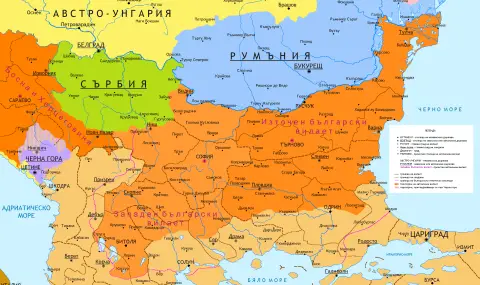The conference was convened on December 23, 1876. It was attended by the ambassadors of the Great Powers - England, Germany, Austria-Hungary, Italy and Russia - and Turkey. Initially (from November 30 to December 10) the Marquis of Salisbury - a special English plenipotentiary, and Count N. P. Ignatiev agreed on the political organization of the Bulgarian lands and Bosnia and Herzegovina. Then preliminary meetings began (December 11-22) without Turkish representatives. The general position was adopted to form 3 autonomous regions, 2 of which were populated by Bulgarians. A draft of organic regulations for the two Bulgarian regions was prepared.
The Russian project envisaged a single Bulgarian autonomous region, including Moesia, Thrace and Macedonia. The Austro-Hungarian Foreign Minister Count G. Andrássy objected to it. The Marquis of Salisbury also objected to a large Bulgarian autonomous region, and the idea of two regions was reached - Eastern, with Tarnovo as its center, and Western - with Sofia as its center (excluding the Aegean Sea and Adrianople and most of the Rhodope Mountains, despite their Bulgarian character).
In the final plan of the conference, the British proposal to divide Bulgaria vertically into two autonomous regions - Eastern, with Tarnovo as its center, and Western - with Sofia as its center. At the meeting on January 8, 1877 The Marquis of Salisbury stated that “within the boundaries of these two provinces, forming Bulgaria, do not include the areas in which the Bulgarian population does not predominate, nor the areas that have not been exposed to the bad administration that made possible the atrocities of last summer.“

The Eastern Bulgarian Autonomous Region includes the sanjaks of Tarnovo, Ruse, Tulcani, Varna, Sliven, Plovdiv (excluding the qadis of Sultaneri and Achchelebi in the Rhodope Mountains) and the qadis of Kirklisi (Lozengrad), Mustafapashovo (Svilengrad) and Kazalagachka (Elhovo) from the Edirne sanjak.
The Western Region includes the sanjaks of Sofia, Vidin, Niš, Skopje, Bitola, part of Ser and the qadis of Strumica, Veles, Tikveš and Kostur.
Thus, the Bulgarian regions are withdrawn from the Aegean Sea and outside them remain Vodensko, Kukush and Doyransko, Western Thrace, most of Eastern Thrace and most of the Rhodope Mountains.
The English representative wants the vertical division of Bulgarian lands, as he believes that the eastern half is inhabited mainly by Turks and Greeks and should be governed separately. In fact, the main issue is not the liberation of Bulgaria, but how to balance the interests of the Great Powers so that Russia does not strengthen its positions too much.
Therefore, the draft organic statute proposes autonomy for the two Bulgarian regions - not a state or states, nor freedom and independence. The organic statute provides that the basic administrative unit will be the canton with 5 to 10 thousand people, regrouped according to their religious affiliation (Christian and Muslim). Several cantons form a sanjak, which is governed by a mutesarif (Christian or Muslim, according to the majority of the population in the sanjak), who is appointed by the Sublime Porte. Several sanjaks form a region, governed by a vali, appointed for a term of 5 years by the Sublime Porte with the consent of the Great Powers. The vali was to be a Christian, or perhaps a foreigner. 30% of the taxes are collected by the Ottoman government.
The judicial system is to be organized according to Ottoman civil law. The Turkish army remains in the provincial cities and fortresses, a militia and a gendarmerie are to be created, whose officers are appointed by the Sublime Porte. An international supervisory commission is to monitor the implementation of these agreements for 1 year. All projects of the Central Committee are aimed at preserving the Ottoman Empire as a counterweight to Russia, which is striving to conquer or bring under its control the Bosphorus and the Dardanelles. At the official opening on December 23, 1876, Savfet Mehmed Pasha, presiding over the meeting, rejects the grounds for convening the conference, based on the announced new Turkish constitution.
This, according to the plan of the Sultan's government, was to take the ground from under the feet of the conference, to make it pointless. Immediately after Savfet Pasha's speech, cannons thundered announcing the proclamation of the constitution. The intransigence of the Turks blocked the conference and failed it.
The countries participating in the conference recalled their ambassadors from Constantinople in protest. The congress did not reach a final decision.
On March 19 (31), 1877, the so-called London Protocol was signed in London - the last diplomatic attempt by the Great Powers to influence the Ottoman Empire with a view to resolving the problem peacefully. The refusal of the Sublime Porte to implement the decisions of the Constantinople Ambassadorial Conference and the London Protocol put an end to peaceful attempts to resolve the Eastern Question, and gave rise to the Russo-Turkish War of 1877 - 78. Together with the April Uprising, the conference was a decisive step on the path to Liberation. With its decisions, the international community legitimized the Bulgarian aspirations to restore Bulgarian statehood in the most authoritative way, while also outlining the natural borders of the Bulgarian ethnicity towards the second half of the nineteenth century.
